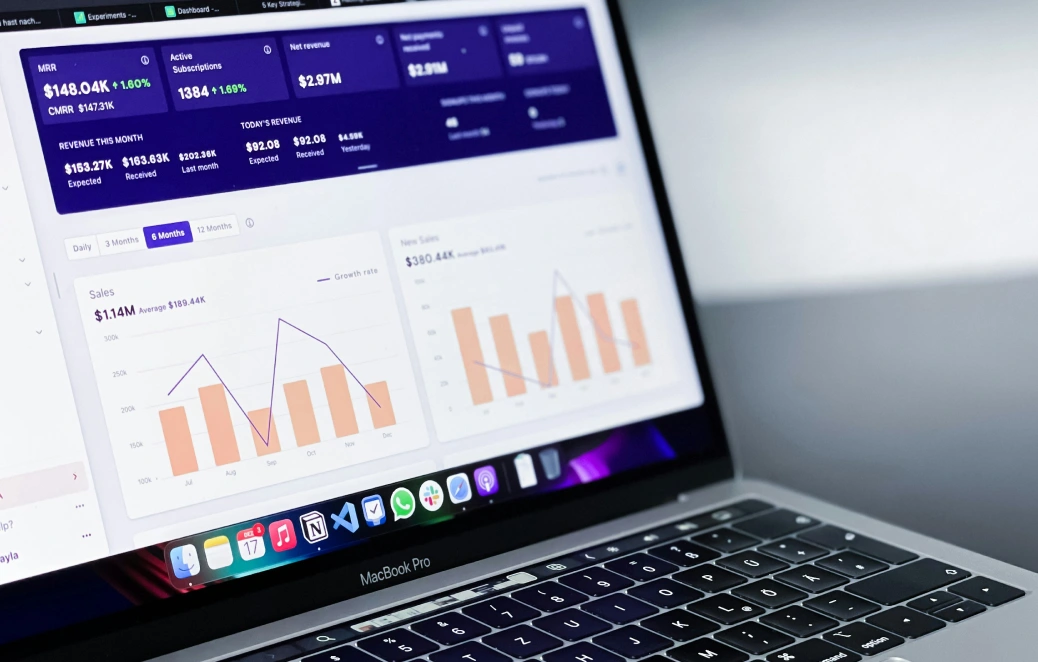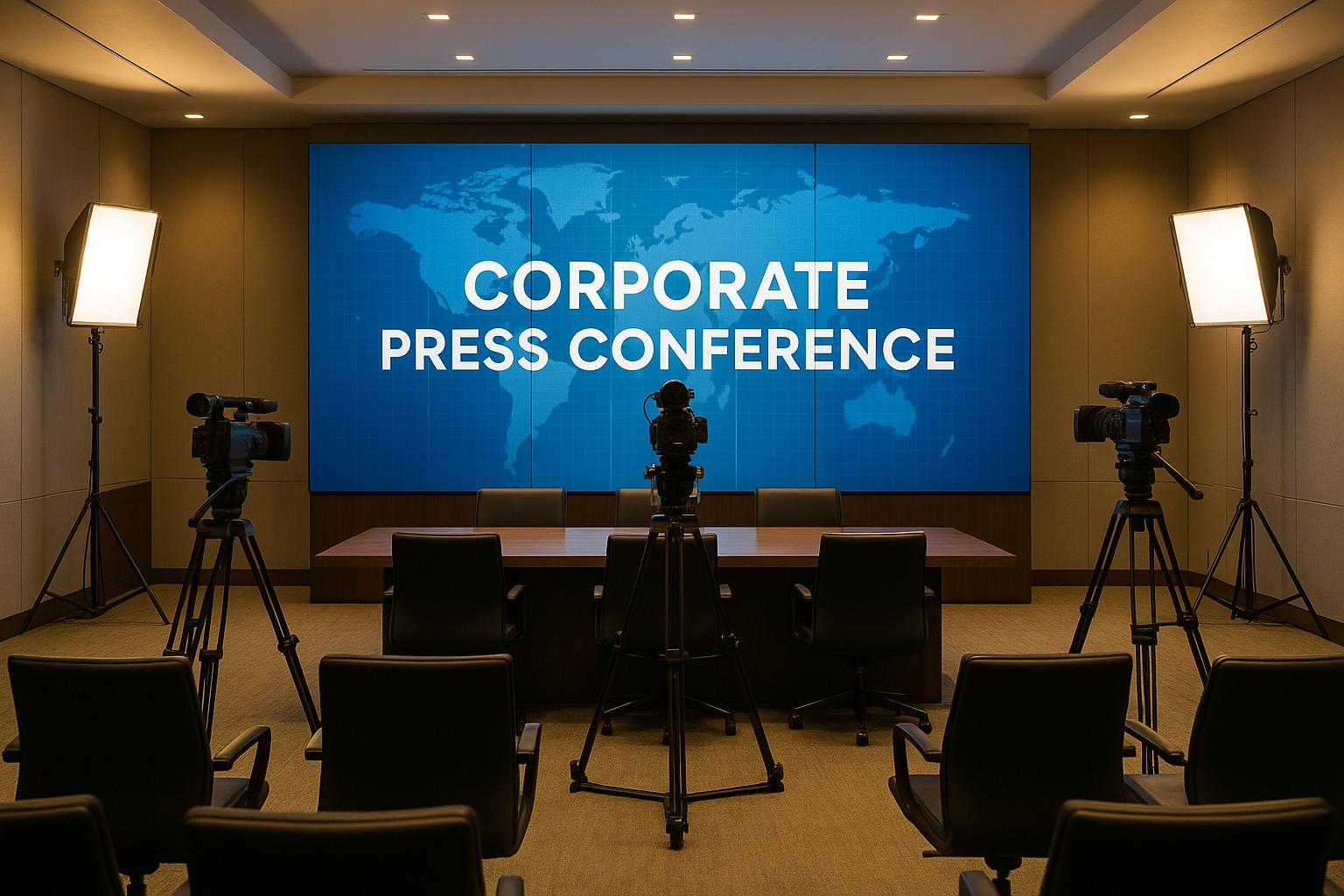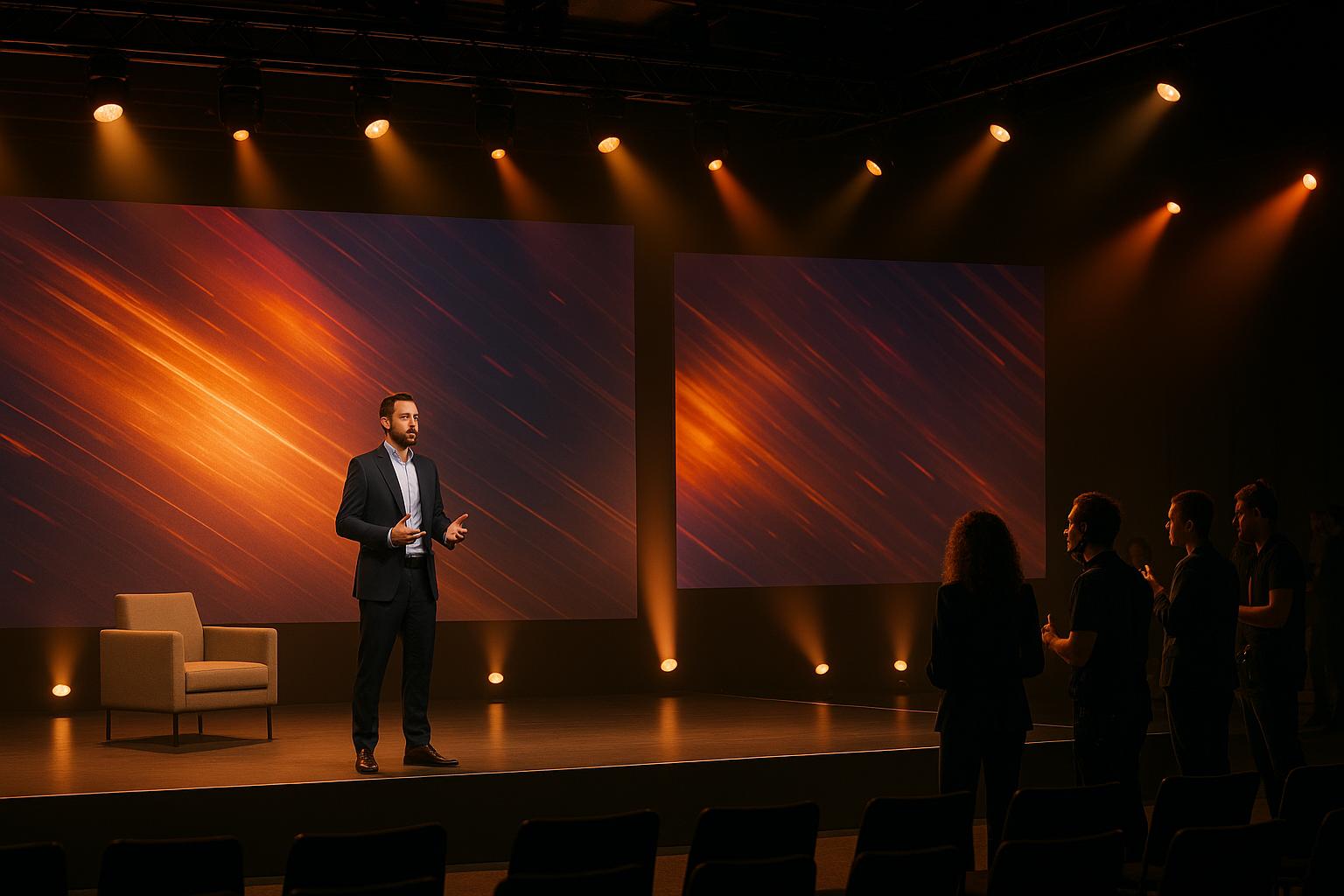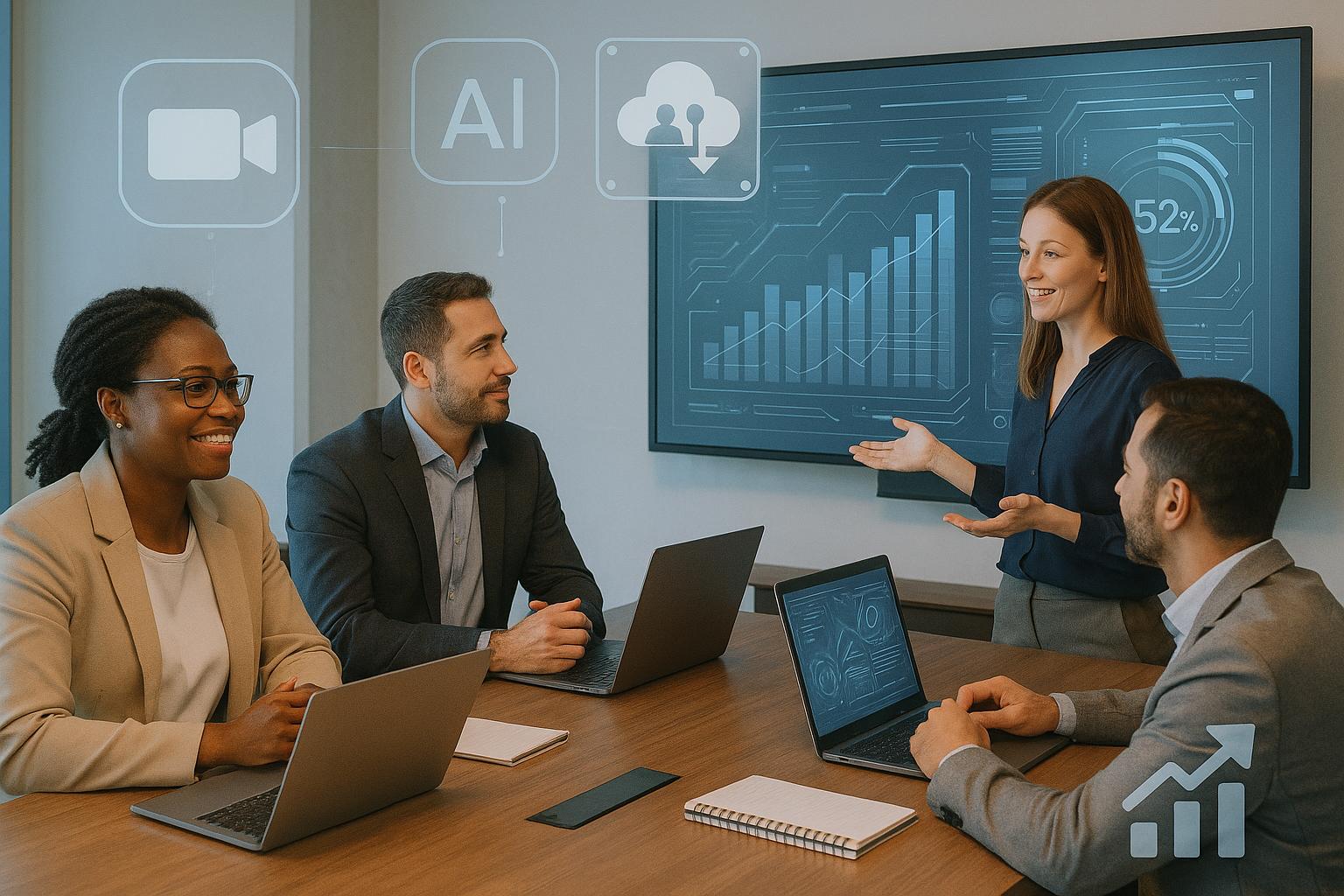Key Elements For A Successful Large-Scale Conference

Chief Executive Officer

Organizing a large-scale conference demands precise planning and execution. From setting clear goals to managing logistics, every detail matters. Here's what you need to know:
- Define Clear Objectives: Establish measurable goals, like increasing leads or boosting attendance. Share these with stakeholders early.
- Coordinate Stakeholders: Use a stakeholder matrix to align roles, priorities, and decision-making protocols.
- Choose the Right Venue: Prioritize capacity, accessibility, parking, and tech readiness. Ensure inclusivity standards are met.
- Plan Logistics: Streamline registration, navigation, catering, and safety protocols. Prepare for unexpected challenges with contingency plans.
- Leverage Technology: Use event apps, live streaming, and interactive tools like polling to boost engagement.
- Craft an Engaging Agenda: Balance keynotes, breakout sessions, and networking opportunities. Schedule strategically based on attendee energy levels.
- Manage Budgets Effectively: Track expenses, negotiate contracts, and allocate a contingency fund for unforeseen costs.
- Post-Event Review: Gather feedback, analyze data, and conduct team debriefs to improve future events.
A successful conference combines clear goals, effective coordination, and a focus on attendee experience. By addressing these elements, you'll ensure your event leaves a lasting impact.
Go behind the scenes how to plan a successful conference
Setting Clear Objectives and Coordinating Key Stakeholders
The difference between a conference that runs like clockwork and one that feels chaotic often boils down to two key factors: clear objectives and effective coordination among stakeholders. Without these elements, even the most detailed plans can crumble under pressure.
Think of your conference objectives as the foundation for every decision you make. They influence everything - venue selection, speakers, marketing plans, and budgeting. At the same time, successful stakeholder coordination ensures that everyone involved - executives, sponsors, vendors, and team members - is aligned and working toward shared goals.
Identifying Conference Goals
Before diving into logistics, it’s essential to define the primary goal of your conference.
Is the event focused on education, networking, launching a product, or boosting brand awareness? Once you’ve pinpointed the purpose, set specific, measurable targets. For example, instead of saying, “increase brand awareness,” aim for something like: “generate 500 qualified leads and achieve a 50% increase in social media mentions during the event week.” Clear targets like these help guide your decisions and provide benchmarks for success.
Document your objectives in a conference charter that outlines the primary goal, target audience, key messages, success metrics, and budget parameters. Share this document with all stakeholders from the outset to ensure everyone is on the same page.
Working with Stakeholders and Decision-Makers
Organizing a large-scale conference means juggling the needs and input of many stakeholders. Engaging these stakeholders early and maintaining clear communication throughout the process is critical.
Start by identifying all key players and understanding their priorities. For example:
- Executive sponsors are often focused on ROI, brand visibility, and the event’s alignment with broader strategies.
- Department heads care about their team’s involvement and resource needs.
- Marketing teams are driven by lead generation and brand messaging goals.
- Finance teams prioritize staying within budget.
- Vendors and suppliers require clear instructions and timelines.
To keep everything organized, create a stakeholder matrix that details each person’s role, decision-making authority, communication preferences, and concerns. This tool ensures everyone knows their responsibilities and helps avoid miscommunication.
Establish regular communication routines early on. Weekly meetings work well for core planning teams, while monthly updates might suffice for executives. Use consistent reporting formats to highlight progress, upcoming decisions, and any challenges that need attention.
Clearly defined decision-making protocols can prevent delays and confusion. Specify who has the final say on critical aspects like venue selection, speaker approval, budget adjustments, or marketing strategies. Document these decisions and assign a single point of contact for each stakeholder group to streamline communication.
When priorities clash, conflict resolution strategies are essential. Set ground rules for resolving disagreements, such as referring back to the conference’s original objectives or escalating the issue to executive sponsors if needed. Address conflicts quickly to keep the planning process on track.
Regular alignment check-ins are another way to ensure everyone remains on the same page. Schedule formal reviews at key milestones to confirm that stakeholders support the direction and resource allocation.
Finally, maintain transparency through shared dashboards, meeting notes, and decision logs that stakeholders can access anytime. This level of openness builds trust and demonstrates strong project management.
Defining clear objectives early on and remaining adaptable to valid concerns will not only strengthen relationships but also lead to a smoother planning process and a more successful event. With aligned goals and clearly defined roles, you’ll be well-prepared to tackle venue selection and logistics planning.
Selecting Venues and Managing Event Logistics
Once you've set your objectives and aligned your team, the next step is picking the perfect venue and nailing down the logistics. The venue sets the stage for your event, while well-executed logistics ensure everything flows smoothly - from the moment attendees check in to the final applause.
Getting these details right takes careful planning. The choices you make here will directly influence your attendees' experience, your speakers' performance, and the overall success of your event. Let’s break it down.
Key Venue Selection Factors
Capacity and layout matter. It’s not just about fitting everyone into one room. Large events often require multiple spaces - think breakout rooms, networking areas, exhibition halls, and a smooth registration zone. Make sure the venue can accommodate all your planned activities without feeling cramped or disorganized.
Accessibility is key. Ideally, your venue should be easy to reach, especially for out-of-town guests. Look for a location close to hotels, restaurants, and public transportation. A central spot, such as a downtown convention center, is often a smart pick for business events.
Inclusivity is non-negotiable. Ensure the venue complies with ADA standards. That means wheelchair-accessible entrances, elevators, restrooms, and seating. Check for features like assistive listening systems, clear sight lines, and proper lighting to make the event welcoming for everyone.
Parking can’t be overlooked. Confirm there’s enough parking for your attendees and factor any associated costs into your budget. If parking is limited, consider offering shuttle services or providing clear guidance on alternative options.
Tech readiness is a must. Reliable Wi-Fi, plenty of power outlets, and strong cellular coverage are essential. Check if the venue has built-in audiovisual systems and explore options for dedicated event networks to keep everything running smoothly.
Catering options vary. Some venues require you to use their in-house catering, while others allow outside vendors. Review the menu options, dietary accommodations, and service styles to ensure they align with your event’s needs.
Setup logistics can’t be an afterthought. Make sure the venue has proper access for deliveries, designated loading zones, and enough time for setup. Confirm any additional requirements, like extra labor or equipment, to avoid last-minute surprises.
Planning Event Logistics
Once the venue is locked in, it’s time to focus on the nuts and bolts of event logistics.
Streamline registration and check-in. Set up multiple stations to handle peak arrival times, use clear signage, and ensure enough staff are on hand. Digital check-in solutions can help speed things up and reduce lines.
Make navigation simple. A solid signage plan is essential, especially for large venues. Use clear, branded signs for directions, room names, sponsor shout-outs, and emergency details. Legible fonts and consistent design go a long way in keeping things clear.
Plan catering thoughtfully. It’s not just about the food - timing matters too. Schedule meal breaks that allow attendees to refuel and network without cutting into key sessions. Be sure to accommodate dietary restrictions and follow local food safety standards.
Think about transportation. If your venue is spread across multiple locations or attendees are staying at various hotels, shuttle services might be necessary. Provide clear schedules, pickup points, and contact info for transportation coordinators to keep things running smoothly.
Prioritize safety and security. Have clear protocols in place for emergencies, including medical incidents, evacuations, and incident reporting. For larger events, on-site medical staff and communication with local emergency services are a good idea.
Coordinate with vendors. Create detailed timelines for vendor access and setup requirements. Assign a single point of contact to manage communication between vendors and the venue team, ensuring everyone stays on the same page.
Don’t forget storage and office space. Secure storage for materials like registration supplies, giveaways, and emergency kits is crucial. A dedicated command center with reliable communication tools can help your team stay organized and handle any issues that arise.
Be ready for the unexpected. Contingency plans are your safety net. Prepare for potential disruptions like tech glitches, no-show speakers, bad weather, or vendor delays. Having backup strategies in place will help you handle surprises with minimal fuss.
Using Technology and Program Design to Increase Engagement
Now that your venue is locked in and logistics are sorted, it’s time to focus on what will make your conference truly stand out - using technology and crafting a program that keeps attendees engaged from the first session to the last. The right combination of interactive tools and thoughtful scheduling can turn a routine corporate event into something attendees will remember and talk about long after it’s over.
Modern audiences expect seamless tech integration, opportunities for real-time interaction, and programming that respects their time while delivering meaningful content. Achieving this balance requires careful planning, both in your choice of tools and how you structure the event itself. Let’s dive into how you can use technology and smart program design to maintain engagement throughout your conference.
Implementing Audiovisual and Interactive Technology
Begin with a solid AV setup. Your audiovisual equipment is the foundation for everything else. Clear audio, high-definition visuals visible from every seat, and professional lighting are non-negotiable. Poor sound quality - whether it’s muffled audio or distracting echoes - can cause attendees to check out quickly. Don’t let technical hiccups overshadow your content.
Flawless live streaming is key for hybrid events. With hybrid conferences becoming the norm, it’s crucial to create a seamless experience for remote attendees. A professional-grade streaming setup ensures that online participants feel included, not like they’re simply watching from the sidelines. Smooth transitions and consistent quality are essential to keep them engaged.
Event apps serve as a digital command center. A well-designed app does more than list schedules and speaker bios. It can include features like live polling, Q&A tools, networking options, and push notifications for updates or reminders. The key is simplicity - your app should be intuitive enough that attendees actually use it throughout the event.
Interactive polling energizes sessions. Tools for live polling can turn passive listeners into active participants. Whether you’re gauging opinions, collecting feedback, or running quick surveys, these tools provide immediate insights and make sessions feel dynamic.
Digital signage keeps everyone informed in real time. Strategically placed screens can display session updates, social media highlights, and sponsor messages. This reduces the burden on staff while ensuring attendees stay in the loop wherever they are in the venue.
Reliable Wi-Fi is non-negotiable. Make sure your internet setup can handle the demands of an event, from streaming to app usage.
Leverage AI for smarter event management. AI-powered tools can simplify tasks like optimizing schedules, tracking engagement, and analyzing data in real time. These insights can help you make informed adjustments on the fly and improve future events.
By combining these tools, you can create a connected, interactive experience that keeps attendees engaged and informed.
Building an Effective Conference Agenda
Once your technology is in place, the next step is to design an agenda that keeps energy levels high while delivering value.
Structure your agenda to align with your event’s goals. A well-balanced program alternates between high-energy keynotes, focused breakout sessions, and strategic networking breaks. Avoid scheduling back-to-back presentations that can overwhelm attendees. Instead, mix up session formats - follow an intensive workshop with a lighter panel discussion or a networking activity.
Keynotes should set the tone. The opening and closing keynotes are your chance to inspire and energize. Choose speakers who can connect with your audience and address their current challenges while leaving them with actionable insights. A powerful keynote can set the mood for the entire event and leave a lasting impression.
Offer breakout sessions for different interests and expertise levels. Tailor smaller sessions to specific topics or skill levels, allowing attendees to dive deeper into areas that matter most to them. Consider creating learning tracks so participants can follow a cohesive path throughout the day.
Make networking purposeful. Instead of relying on casual mingling, organize structured networking activities, such as themed meetups or conversation starters. Use your event app to help attendees identify and connect with others who share similar interests or goals.
Schedule strategically based on energy levels. Plan your most critical sessions for mid-morning or early afternoon when attendees are most alert. Avoid placing key content right after lunch, when energy tends to dip. Build in buffer time for room changes and breaks to keep the day running smoothly.
Incorporate interactive elements throughout. Don’t limit audience participation to Q&A sessions. Include activities like live polls, workshops with hands-on exercises, or panel discussions that invite audience questions. These elements make sessions more dynamic and memorable.
Allow flexibility for real-time changes. Build some wiggle room into your schedule to accommodate unexpected delays, extend popular sessions, or add impromptu discussions. Having optional activities or backup plans can help you adapt without disrupting the flow.
Cater to different learning styles. Not everyone learns the same way. Combine lectures, hands-on workshops, roundtable discussions, and interactive demonstrations to ensure there’s something for everyone. A diverse agenda keeps things fresh and ensures attendees stay engaged.
sbb-itb-ae35a94
Budget Planning and Financial Management
Once your conference strategy is in place, the next step is creating a detailed budget that accounts for every aspect of the event. A well-thought-out budget not only keeps spending in check but also acts as a guide for making smart decisions throughout the planning process. This ensures your event delivers value without going overboard on costs.
Large conferences often involve numerous expenses, each contributing to the overall financial picture. From securing venue deposits to handling last-minute travel changes for speakers, every choice matters. The goal is to craft a budget that covers predictable expenses while leaving room for unexpected surprises.
Developing a Complete Budget Plan
Start by identifying the major cost categories. For most conferences, the venue is a significant expense, often taking up 30–40% of the total budget. This includes not just the rental fee but also setup and breakdown charges, security deposits, and additional fees for extended hours or unique requests. Keep in mind that venues may charge extra for things like upgraded Wi‑Fi, additional power outlets, or climate control adjustments, which can quickly add up.
Audiovisual (AV) costs are another critical component, typically accounting for 15–25% of the budget. Break these expenses down carefully, including microphones, projectors, screens, sound systems, lighting rigs, and the technicians required to operate them. Don’t forget to budget for backup equipment to avoid disruptions due to technical issues.
Catering expenses go beyond food and drinks. You’ll need to include costs for service staff, linens, tableware, setup and cleanup, and gratuities. Depending on your location and menu choices, catering can range from $75 to $150 per person per day. Similarly, speaker and entertainment costs extend beyond appearance fees. Factor in travel, hotel stays, ground transportation, meals, and any special requests. For example, while a keynote speaker’s fee might be around $15,000, premium travel and accommodations can push the total much higher.
Marketing and promotional efforts deserve their own budget allocation. This might include website development, registration platforms, printed materials, signage, promotional items, and digital advertising. Even small items like badges and lanyards can cost $3–$5 per attendee when you account for design and printing.
Staffing costs are another area to consider. Beyond your core team, you’ll likely need to budget for temporary staff, including registration desk personnel, technical support, security, and cleaning crews. Some venues with union requirements may necessitate specific staffing arrangements, which can significantly impact costs.
Don’t forget about hidden expenses that can sneak up on you. These might include permit fees, insurance requirements, overtime charges for venue staff, internet bandwidth upgrades, additional cleaning fees, or storage costs for materials that arrive early. For example, special event permits in certain cities can cost thousands of dollars, and local insurance mandates can add to your expenses. To prepare for the unexpected, set aside a contingency fund of 15–20% of your total budget.
Once you’ve outlined your cost categories, the next step is managing expenses and vendor relationships in real time.
Monitoring Expenses and Managing Vendors
Use project management tools to track expenses in real time and set a policy requiring approval for expenditures above $500–$1,000. This helps prevent small overruns from snowballing into major financial issues.
Negotiate clear contracts with vendors that specify payment schedules and deliverables. For example, a catering contract should outline the menu, service style, staff-to-guest ratios, and setup requirements to avoid surprise costs. Instead of large upfront payments, consider staggered payment schedules - such as 25% at contract signing, 50% thirty days before the event, and the final 25% after the event is successfully completed. This approach protects your cash flow and ensures vendors meet their commitments.
Vendor scorecards can be a helpful tool for evaluating performance. Track metrics like delivery timelines, quality standards, and responsiveness to changes. This allows you to identify reliable partners and address any issues before they affect your budget.
Hold regular budget review meetings - weekly as the event date approaches - to address any variances promptly. For instance, if AV costs start trending 10% over budget, you can explore adjustments or reallocate funds from other areas. Document any changes to the budget for future reference, and consider using purchase orders for major expenses to maintain a clear paper trail and prevent unauthorized spending.
If working with international vendors, plan ahead for currency fluctuations. Lock in favorable rates early or include a currency buffer in your budget to avoid surprises. Effective financial management ensures you get the most out of every dollar while staying flexible enough to adapt to changing circumstances.
Post-Event Review and Future Improvements
Once your conference wraps up and the attendees head home, the real work begins: reviewing the event and identifying ways to improve. A thorough post-event review transforms your experiences into actionable insights, helping you refine future events and avoid repeating past mistakes.
It's best to start this process as soon as possible after the event. When feedback is fresh and details are clear in everyone’s minds, it’s easier to gather accurate and useful information.
Gathering Feedback and Measuring Results
To get a complete picture of your event’s success, gather feedback from all key players - attendees, speakers, sponsors, vendors, and your team.
- Attendee Surveys: Send out surveys immediately after the event. Keep them short and focused to maximize responses. Ask about session quality, venue comfort, networking opportunities, and overall satisfaction. Use a mix of rating scales and open-ended questions to capture both data and insights.
- Speaker Feedback: Provide speakers with their own feedback forms. Ask about technical support, facilities, audience engagement, and logistics. This can highlight operational issues that attendees might not notice.
- Sponsor Input: Evaluate sponsor satisfaction by focusing on booth placement, lead generation, networking access, and brand visibility. Use these insights to strengthen your sponsor proposals for future events.
- Attendance Data: Analyze registration and attendance numbers. Compare how many registered versus how many showed up, and study session attendance to see which topics resonated most with your audience.
- Financial Review: Compare your financial performance to your original budget. Calculate the cost per attendee and note any budget overruns or savings to improve future financial planning.
- Social Media Metrics: Check hashtag usage, engagement rates, and overall sentiment on platforms like LinkedIn, Twitter, and Instagram. High engagement often signals attendee satisfaction and boosts your event’s reach.
Additionally, tools like Corporate Optics can provide detailed analytics on attendee behavior, session popularity, and engagement. These insights can help you identify what worked and what needs adjustment for next time.
Conducting Team Reviews and Learning from Results
After gathering external feedback, turn inward and conduct a team debrief. This is your chance to hear directly from the people who made the event happen.
Focus the discussion on three key areas: what worked well, what didn’t, and what should change next time. Encourage team members to share specific examples. For instance, instead of saying “registration was slow,” pinpoint any technical or logistical issues that caused delays.
- Vendor Performance: Review how well your vendors delivered. Were they reliable, responsive, and on time? Scorecards can help track their performance and guide future negotiations.
- Contingency Plans: Evaluate how backup measures performed. If you had to use a secondary audio system during a keynote, was the transition smooth? Did it affect the overall experience?
- Timelines: Compare your planned schedule to what actually happened. If certain tasks consistently ran over time, adjust your planning for future events.
- Communication: Assess how well information was shared internally and externally. Did stakeholders receive timely updates on schedule changes, venue details, or networking opportunities?
Document everything - successes, challenges, and lessons learned. For instance, if a particular improvement boosted attendee satisfaction, make a note to repeat it. Similarly, outline step-by-step procedures for critical tasks like registration or speaker logistics to ensure continuity.
End the review process with a comprehensive report. This document becomes a valuable resource for future planning, preserving insights even if team members change. Set clear, measurable goals based on your findings. Instead of vague objectives, focus on specific targets you can track, like reducing no-show rates or improving session engagement. Regular check-ins throughout the year can keep these goals on track and support early planning for your next event.
Conclusion: Core Elements for Successful Large-Scale Conferences
Organizing a large-scale conference is like piecing together a complex puzzle - every element must fit perfectly to create a memorable experience for attendees. From setting clear goals to reflecting on the event afterward, each step plays a critical role in determining success.
At the heart of it all are well-defined objectives and aligned stakeholders. When everyone involved shares a clear vision of success, decision-making becomes more focused and efficient throughout the planning process.
Choosing the right venue and managing logistics are equally crucial. A venue isn't just a space; it shapes the event's atmosphere, facilitates networking, and supports technical needs. Add to this a well-thought-out logistics plan, and you’ll ensure that everything - from registration to the closing session - runs without a hitch.
In today's world, technology and program design are game-changers. Attendees expect more than just presentations - they want interactive experiences, seamless tech, and a schedule that keeps them engaged. The right tools and a thoughtfully structured agenda can turn passive attendees into active participants.
Of course, none of this works without financial discipline. Keeping a close eye on your budget ensures the conference remains sustainable. Tracking costs, understanding the financial impact per attendee, and evaluating performance against your objectives provide a solid foundation for future planning.
Finally, post-event analysis is where the magic of continuous improvement happens. Gathering feedback from everyone involved - attendees, speakers, sponsors, and your team - creates a treasure trove of insights. These learnings help fine-tune future events, turning one-time successes into a growing legacy.
The best large-scale conferences don’t just excel in one area - they bring all these components together into a cohesive strategy. By aligning objectives, selecting venues thoughtfully, leveraging technology, managing budgets carefully, and learning from every experience, you can ensure your conferences leave a lasting impact year after year.
FAQs
How can I coordinate effectively with all stakeholders when planning a large-scale conference?
Effective coordination with stakeholders starts with establishing clear objectives and fostering open, honest communication from the outset. Regular check-ins are essential - they help align expectations, resolve any concerns, and strengthen trust among everyone involved.
Involve stakeholders early in the planning process and make use of tools like shared calendars or project management platforms to keep everyone updated and aligned. These tools not only simplify collaboration but also make decision-making more efficient throughout the event planning process.
How can I choose a venue that accommodates both attendee capacity and inclusivity needs?
When choosing a venue, it’s important to ensure the space is welcoming and easy to navigate for everyone. Check for features like ramps, elevators, wide doorways, and pathways free of obstacles to make sure individuals with mobility challenges can move around comfortably. Also, verify that the venue has enough space for your expected crowd and offers flexible layouts to meet various needs, including those of attendees with disabilities. Prioritizing these factors helps create an environment where everyone feels included and valued.
How can event planners use technology to boost attendee engagement and create a smooth conference experience?
Technology has become an essential part of boosting attendee involvement and creating a smooth conference experience. Tools like live polls, Q&A sessions, and real-time surveys make it easy for participants to actively engage, share their opinions, and connect with speakers and content in meaningful ways.
High-quality audiovisual setups, including crisp displays and top-notch sound systems, bring presentations to life with sharp visuals and rich audio. On top of that, event apps simplify the experience for attendees by offering handy features like tailored schedules, interactive maps, and real-time notifications, making the entire event more organized and enjoyable.
Related Blog Posts









